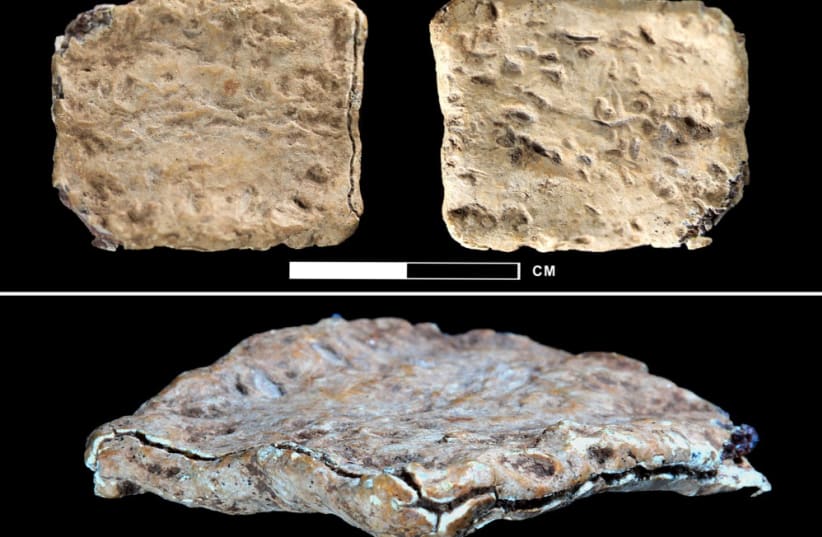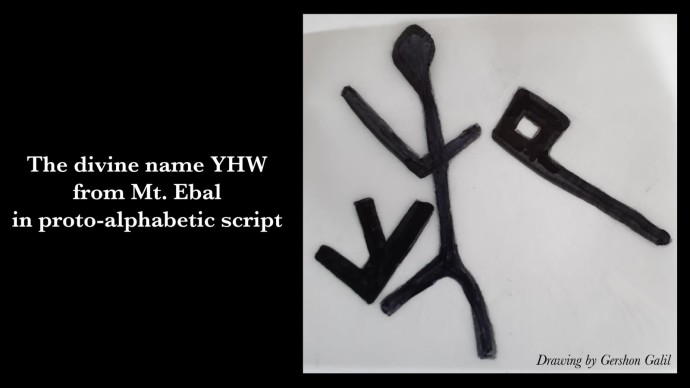Dr. Scott Stripling, director of excavations for the Associates for Biblical Research (ABR) at ancient Shiloh, presented Thursday recent revelations about what he said might be the most significant discovery in biblical archaeology in recent years.
The discovery comes in the form of a lead amulet measuring two centimeters square found by wet-sifting material taken from a site on Mount Ebal excavated by Prof. Adam Zertal more than 30 years ago. A square altar dated to the 13th century BC had been built on top of an older circular altar Zertal believed was built by Joshua upon entering the land of Israel, as described in the Bible:
“At that time Joshua built an altar to the LORD, the God of Israel, on Mount Ebal” (Josh. 8:30).
Discovered by Stripling’s team in 2020, the metal amulet remained a mystery.
Folded in half, the letters inscribed in the lead foil were indecipherable and the metal was too brittle to unfold. The ABR team contacted researchers in Prague who used tomographic scans - similar to medical diagnostic CT scans - to recover the hidden text.
The scans revealed an ancient proto-alphabetic Hebrew inscription consisting of 40 letters that is centuries older than any known Hebrew inscription from ancient Israel.
Epigraphers (specialists in deciphering ancient texts), Pieter Gert van der Veen of Johannes Gutenberg-Universität Mainz and Gershon Galil of the University of Haifa, determined that the lead amulet was a defixio: a curse tablet.
The word “cursed” (aroor) appeared 10 times. And, the tetragrammaton, the four-letter ineffable name of God usually written in English as YHWH, appeared twice:
Cursed, cursed, cursed - cursed by the God YHWH.You will die cursed.Cursed you will surely die.Cursed by YHWH – cursed, cursed, cursed.
Stripling revealed some of the more astounding aspects of this discovery at a media event held on Thursday evening.
Zertal’s excavated pottery dated to the Iron Age I and Late Bronze Age, so logically the tablet derived from one of these earlier periods.
“I believe the amulet dates to the Late Bronze II age, or as early as 1400 BC,” Stripling told The Jerusalem Post. “This is older than any Hebrew script that has ever been published by at least 200 years.
“This is earlier than many skeptics believe the Bible existed,” he continued, “making this the earliest appearance of the word YHWH in Israel and it was found at a covenant site. The implications are enormous and will reverberate for many years to come.”
Mount Ebal where the amulet was found was the mountain from which the curses were called out when the children of Israel made a covenant with God before entering the land of Israel.
And it shall come to pass, when the LORD thy God shall bring thee into the land whither thou goest to possess it, that thou shalt set the blessing upon mount Gerizim, and the curse upon mount Ebal (Deuteronomy 11:29).
Stripling stated his belief that the amulet correlates chronologically with the covenant renewal ceremony. Van der Veen concurred.
“I think it is plausible that there is a connection,” Van der Veen said. “The very fact that the amulet refers to ‘curse’ and Mount Ebal is referred to as where the curses were read out, I think clinches the connection between this amulet and the covenant renewal ceremony.”
Galil noted that the text referred to death as did the biblical account in which the children of Israel were enjoined to choose between life and death.
Another implication is also evident.
“This changes our timeline for the Exodus from Egypt and subsequent entry into Israel,” Stripling said. Scholars are at near consensus that the Exodus and Israelite establishment in Canaan happened during the 13th century BC.
“The conquest would have had to take place at an earlier date,” Stripling said.
Galil analyzed the text:
“It is clear that the person who inscribed the text was a genius,” Galil said. “He was probably a leader. The amulet was intentionally left near this cultic site. My conclusion is that the biblical story of Joshua’s altar is a historical fact.”
Stripling added that they found flat plaster-covered stones buried inside the altar. This is consistent with the biblical account found in Deuteronomy 27:4.
The amulet also has implications for how scholars view the Bible.
“Our friends from the other side of the academic aisle have spoken disparagingly, saying that it was not possible because there was no alphabetic script with which to write it,” Stripling said. “The discovery of this amulet flies in the face of that. One can no longer argue with a straight face that the biblical text was not written until the Persian or Hellenistic period.
“This amulet and its inscription do not predate the Bible,” he continued. ”We believe it coincides with the biblical events. We talk about verisimilitude, a consistency between what we read in the text and what we find in the material culture. If the text were true, this is what you would anticipate finding, and indeed, it is what we found.”

